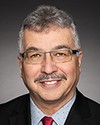Thank you, Mr. Chair.
I'm hoping that the interpreters can hear me. I've made some adjustments to my microphone.
I want to say, first of all, welcome to all the presenters today. I really appreciate having Manny Jules, Harold Calla and former northerner Ernie Daniels, a colleague of mine from way back, appearing before us.
There are some very interesting points being made. I'm hoping, Mr. Chairman, that these three individuals will provide us with the documents, which some of them have referenced, for us to use as part of our review of this issue in committee.
I don't have to tell any of these three how important this issue is. Looking at the barriers and at the issue of economic reconciliation is very important for us if we are to move forward. It's a big part of reconciliation. In the Northwest Territories, we've been doing a lot of work on this issue because it has to be part of the plan of nation rebuilding and reconstituting nations, that is, the question of how we're going to govern ourselves and how we're going to finance ourselves. The financing scheme has to be very diverse because there's no one pot of money we can dip into.
We've been talking a lot about resource revenue sharing, and at our last Liberal convention, we passed a motion that 50% of resource revenues that are raised and that go to the federal government and the Northwest Territories would go to the indigenous governments, and we've been talking about taxation of our own membership once we sign and settle self-governance agreements and move forward on land tenure.
Another big piece is the review of indigenous procurement. Up to now, the procurement policies have just not been working. They're so old and outdated that they don't work for us, and they're cumbersome to use.
There are lots of things happening. I was very keen to see the document, the article, that Ernie Daniels put forward on replacing the diesel generators in the Northwest Territories. I think, Ernie, you talked about looking at one pot of money, and I think you referenced the money that's there for infrastructure for indigenous communities, but I'm curious to know if you're not looking at other funding sources or pots of money. There was a pot of money through the Arctic energy fund. I think there was $400 million in there.
Would a combination of different funding sources from the government allow you to move forward and do a pilot project? That's my first question, and then I'll follow up with a second question once you've referred to that.





